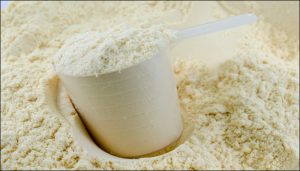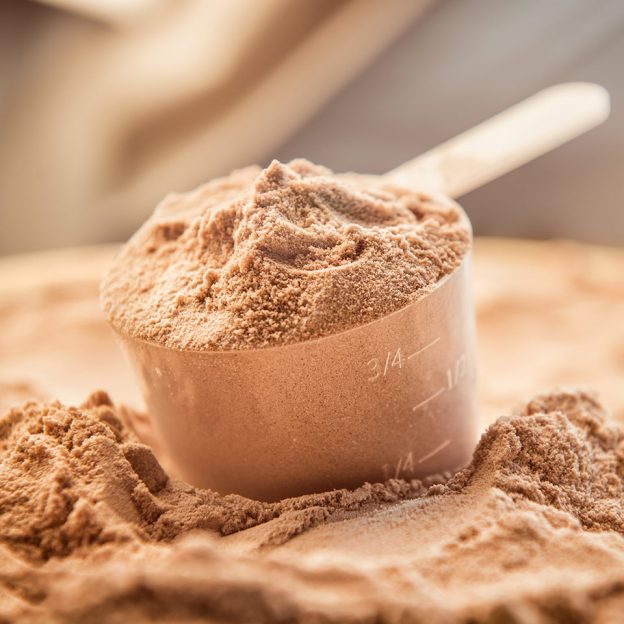By Anthoney J. Andersen – Steroidal.com
If you’re a bodybuilder, or just an exercise enthusiast who finds him or herself at the gym at least three to four times a week, then it’s important to note that you should be consuming an adequate amount of protein.
High-protein, low-carbohydrate diets are the hottest thing since Gal Gadot decided to pack on the lean muscle, strap on the Wonder Woman armor, and storm the German battlefields during WWII.
It appears that every food marketer is scrambling to snatch a piece of the ‘protein pie.’
Bodybuilders are grabbing and gulping down protein shakes, and dieters are gobbling down protein bars, in hopes of quick weight loss, while replacing any stored fat with lean muscle.
But with the wide range of whey protein supplements sold at vitamin shops, which ones do nutritionists and bodybuilders consider to be the best?

Whey Protein Isolate Powder
THE IMPORTANCE OF PROTEIN
Protein is a vital component of every cell in the body. Hair and nails are mostly made of protein. Your body uses protein to help build and repair tissues – which can be an extremely important detail to consider when strength training.
Protein is also an important building block of bones, muscles, cartilage, skin and blood. According to WebMD, protein is a ‘macronutrient,’ meaning that the body needs large amounts of it. Unlike fat and carbohydrates, the body does not store protein, and therefore has no reservoir to draw on it when it needs a new supply.
HOW MUCH PROTEIN IS ENOUGH?
We’ve all heard the myth: ‘More protein builds more muscle.’ However, that simply is not true. In fact, the only way to build muscle is through exercise. Bodies need only a modest amount of protein to function well. According to the U.S. Department of Health and Human Services, the following is the Recommended Daily Allowance (RDA) for protein:
- Women (ages 19-70+): 46 grams/day
- Men (ages 19-70+): 56 grams/day
Consuming high protein foods or supplements can have the following benefits:
- Speeds up recovery after exercise
- Reduces muscle loss
- Builds lean muscle
- Helps your body maintain a healthy weight
- Curbs hunger
THE MARVEL OF WHEY PROTEIN
Whey is a ‘fast’ protein, meaning it is digested and absorbed quickly, and the amino acids are rapidly delivered to the bloodstream, and then to the muscles.
However, in today’s society where most consumer products are rapidly evolving into the next ‘bigger and better thing,’ it can often be confusing trying to differentiate between the different types of whey protein supplements offered in most health food stores.
To alleviate the stress and confusion, the following will breakdown the three types of whey protein.
WHERE DOES WHEY PROTEIN COME FROM?
The origin of whey protein begins on the dairy farm, where cows are milked. The milk is then transported to the manufacturing facility to begin the process of cheese making. Special enzymes are then added to the milk to create the separation of curds and the liquid whey. The whey is usually then pasteurized, filtered and dried into a powder to create whey protein.
THE THREE TYPES OF WHEY PROTEIN
There are three forms of whey protein: whey protein concentrate, whey protein isolate and whey protein hydrolysate.
WHEY PROTEIN CONCENTRATE vs. WHEY PROTEIN ISOLATE
According to Supervitalfoods.com, whey protein concentrate is the least processed form of whey protein, which usually contains anywhere from 30 to 85 percent whey protein – with varying amounts of fat and carbohydrates in the form of lactose, along with various protein subfractions that have important biological activity with significant health benefits.
Although both whey concentrate and whey isolate are both derived from the same milk concentration, whey isolate is simply whey protein that has been filtered in a process to help remove the lactose in the powder itself. This is to create a leaner and lower fat protein source.
According to Myprotein.com, the main difference between whey concentrate and whey isolate is the two products offer different protein content, lactose and fat content per serving. Whey concentrate can offer anywhere between 10 to 15 percent protein content per serving with over 50 percent lactose and almost two percent fat. Whereas, whey isolate contains over 90 percent pure protein content with under one percent lactose or milk fat.
Whey isolate is extremely beneficial for anyone who is lactose intolerant, or has issues digesting dairy.
Both whey concentrate and whey isolate will digest in the body at the same rate/speed, and both contain the same amounts of amino acids (building blocks of proteins).
Let’s take a look at the macronutrients of whey concentrate and whey isolate:
| Macros | Whey Concentrate | Whey Isolate |
| Protein | 20 g | 21 g |
| Carbohydrates | 1.5 g | Less than 1 g |
| Fat | 1.8 g | 0 g |
As you can see, the difference in protein is only one gram, but whey isolate contains barely any carbs, and no fat.
WHEY PROTEIN HYDROLYSATE
According to the National Center for Biotechnology Information, protein hydrolysates are produced from purified protein sources by heating with acid, or preferably, addition of proteolytic enzymes – various enzymes that digest protein – followed by purification procedures.
Whey protein hydrolysate is predigested, meaning the long chains of amino acids typically found in the isolates and concentrates are broken down into single amino acids. Because whey hydrolysate is predigested, it’s thought to result in faster absorption and release of amino acids into the bloodstream – which may lead to slightly greater muscle protein synthesis when ingested after exercise.
According to The Journal of Nutrition, because whey hydrolysates are insulinotropic – stimulating or affecting the production of insulin – consuming whey hydrolysates with easy digesting carbs immediately after training and weight lifting will help maximize the recovery benefits by creating a high level of insulin in your blood plasma levels. Insulin is an anabolic hormone, and is valuable at helping the body grow lean muscle.
Most whey concentrates and isolates are available as intact proteins, but either one can also be hydrolyzed. Because whey hydrolysates have been partially broken down by heat, acid or enzymes, they tend to taste a lot more bitter than whey concentrate or isolate. Concentrates and isolates already have a fast digestion rate, so adding a hydrolysate – which digest minimally faster – may not be worth the taste tradeoff, and extra cost for the small benefit.
CONCLUSION
As long as you don’t mind the few extra grams of carbohydrates and fat – and you’re not lactose intolerant – whey concentrates are the most economical choice, and are currently the best-selling form of whey protein on the market today.







